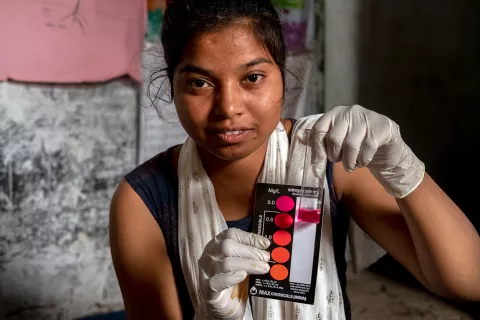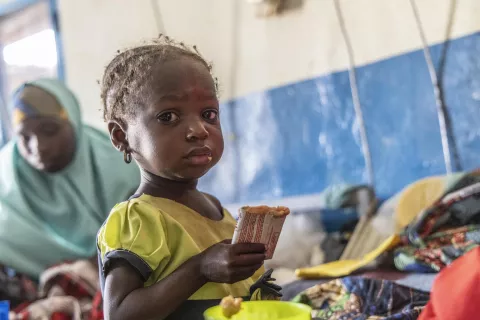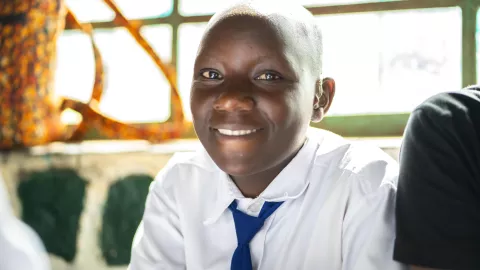Celebrating World Food Day with innovation to combat child malnutrition
One of UNICEF’s latest innovation projects – the Complementary Feeding Bowl – is set for introduction in the MENA region jointly with WFP.

In Syria, one-year-old Alia went several days with barely anything to eat as her family fled from conflict. When admitted to the hospital, she was diagnosed with severe acute malnutrition or wasting. In Mali, two-year old Alimatou may have enough quantity of food to eat, but the lack of nutritional diversity in meals has caused her to be chronically undernourished, or stunted.
What do Alia and Alimatou have in common? Each suffer from a form of malnutrition due to the poor nutritional quality and/or quantity of their diets. For Alia, it’s whatever her family could find as they fled from conflict. And for Alimatou, it’s mainly rice, water and sugar.

A global challenge
Globally, 144 million children under 5 are stunted, 47 million are wasted, and 38 million are overweight. UNICEF estimates that at least one in two children under 5 suffers from hidden hunger, with deficiencies of vitamins and other essential nutrients, and two in three are not fed a minimum diverse diet to grow healthy.
Challenges are often related to conflict or economic factors inhibiting access to a healthy diet involving different food groups. But it may be rooted in a lack of knowledge on the right amount, frequency, and diversity of food needed for children.
The scale and severity the COVID-19 pandemic has brought additional complexities to the situation. Recent estimates indicate that child wasting could rise by 14 per cent, or 6-7 million children, due to the socio-economic impacts of COVID-19. More families are falling below the poverty line and the economic downturn is expected to intensify existing household food insecurity and child malnutrition.
“Far too many of our children are not getting the diets they need, which is undermining their capacity to grow, develop and learn to their full potential. That hurts not just individual children and young people, it hurts us all.”
Over the past three decades, much work has been done to improve the situation, including nutrition counselling for caregivers and providing nutrition supplements for families. Since 2000, the world has reduced the proportion of children under 5 suffering from malnutrition by one third. This remarkable achievement proves that positive change for nutrition at scale is possible and is happening.
But more must be done if millions of children are still suffering from stunting, wasting and hidden hunger.
Good quality counseling on what, when and how children are fed, sits at the heart of good nutrition. Complementing nutrition counseling with utensils to illustrate the quantity and quality of food can empower caregivers to continue the good practices at home.

"WFP saves and changes lives by working towards the goal of ending malnutrition and a shared vision of a world beyond hunger. No child should ever go to bed hungry, so we've got to go out there & be willing to fight for them”
Product innovation for a solution
The complementary feeding bowl, a frugal and practical innovation by UNICEF based on initial work by Emory University, is being tested in several regions, most recently with the World Food Programme (WFP) in MENA, which includes:
- A bowl with dietary diversity messages included in the design to address food quality, and demarcations of age group, volume and number of meals inside the bowl.
- A slotted spoon to ensure that the semi-solid foods are of the right consistency, energy-dense and not watered down.
The theory: If caregivers are given a simple, easy-to-use device, they will be reminded of the children’s nutritional needs, and continue healthy practices at home. So far, prototypes have been tested by Emory University in five countries (including India, Kenya, Malawi) which have all indicated positive results with increases in meal frequency, quantity and thickness of food.
This innovation considers local needs for customizing the bowl, such as food groups and language to ensure acceptability among mothers and families. It also caters for different population groups, for example, by including disability-friendly features. In addition, the nutrition messages in the design will follow UNICEF Global Complementary Feeding Guidance.
Product testing with WFP in the Middle East and North Africa (MENA) region
UNICEF and WFP have joined forces to improve the quality of complementary feeding and nutrition practices for children in the MENA region. Together, they will test the bowl and spoon through small scale implementation in 3-5 countries and gather evidence on acceptability and any need for iterations to the current designs. This may involve incorporating the bowl into UNICEF’s standard infant and young child feeding (IYCF) counselling sessions as well with WFP’s nutrition treatment and prevention programmes, food delivery programming and transfer modalities (food, cash, voucher). Both organizations have committed resources and are working together to refine the designs for local adaptation.
The aim is to improve complementary feeding practices in the region and prevent malnutrition, highly needed in a region with nearly 11 million children who suffer from chronic or acute malnutrition.

The Impact of Innovation
After incorporating improvements with feedback from testing in several regions, the next step is to bring this product to scale. While working together with governments and partners, this innovation has the potential to reach millions of caregivers across countries and regions, both in rural and urban areas.
To learn more about the complementary feeding bowl and other innovation efforts, visit the UNICEF product innovation website. To read more about WFP nutrition programmes visit the WFP website.



